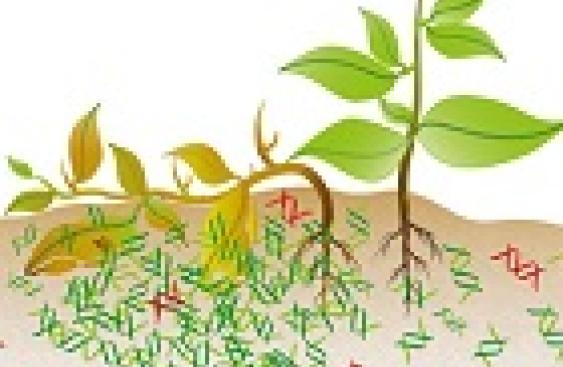Two new Forum articles from Veresoglou et al. (2015) and Duran-Flores and Heil (2015) published in the latest issue of New Phytologist discuss the possible explanations for growth inhibition by extracellular self-DNA in the environment, and the benefits it might yield the organism receiving the signal.
Mazzoleni et al. (2015a, 2015b) recently showed the detrimental effect of extracellular self-DNA on the growth of organisms from a range of taxa, including plants, bacteria, protozoa, fungi, algae and insects. The Letter from Veresoglou et al. (2015) and accompanying Commentary from Duran-Flores and Heil (2015) expand upon the explanation given by Mazzoleni and colleagues for this self-inhibitory mechanism in plants. They agreed with Mazzoleni and coworkers that it could potentially be a mechanism to prevent intraspecific competition, but postulated that extracellular self-DNA might also act as an intraspecific stress signal.
A high concentration of extracellular self-DNA tells plants that a conspecific nearby has been injured or killed. Image credit: Duran-Flores and Heil, 2015.
Cells of damaged or decaying tissues rupture and release their contents to the environment. Veresoglou and colleagues (2015) suggested that the inhibitory effects of these cellular contents on nearby conspecifics could be an example of the released self-DNA acting as a damage-associated molecular pattern (DAMP) molecule, a damage warning signal shown by Duran-Flores and Heil (2014) to be highly species specific. A high concentration of self-DNA released by decaying plant tissue could inform neighbouring plants or seeds to avoid growth in that area, as others of their species have recently been injured or killed there. Duran-Flores and Heil agreed that self-DNA could be a DAMP signal, highlighting several research questions that now need to be answered to better understand the mechanism (Duran-Flores and Heil (2015).
Mazzoleni and colleagues first discovered this inhibitory effect when growing plants in a soil litter consisting of decomposed leaves from the same species (Mazzoleni et al., 2015a). Upon further investigation, it became clear that this autotoxicity was produced by a plant’s contact with extracellular self-DNA fragments, DNA that came from the same species, in a concentration-specific manner.
Mazzoleni and colleagues were able to extend this finding to a range of different organisms by applying DNA to colonies of microscopic organisms, seeds of Acanthus mollis, and larvae of the fly Sarcophaga carnaria (Mazzoleni et al., 2015b). They found that while DNA from a heterologous organism (the plant Arabidopsis thaliana) was not able to significantly impact growth in any of these species, DNA extracted from the same species and applied to the organisms had a profound negative impact on growth.
References
Duran-Flores, D, Heil, M. 2014. Damaged-self recognition in common bean (Phaseolus vulgaris) shows taxonomic specificity and triggers signaling via reactive oxygen species (ROS). Frontiers in Plant Science, 5, article 585.
Duran-Flores, D, Heil, M. 2014. 2015. Growth inhibition by self-DNA: a phenomenon and its multiple explanations. New Phytologist 207: 482–485.
Mazzoleni S, Bonanomi G, Incerti G, Chiusano ML, Termolino P, Mingo A, Senatore M, Giannino F, Cartenì F, Rietkerk M, Lanzotti V. 2015a. . Inhibitory and toxic effects of extracellular self-DNA in litter: a mechanism for negative plant–soil feedbacks? New Phytologist 205: 1195–1210.
Mazzoleni S, Cartenì F, Bonanomi G, Senatore M, Termolino P, Giannino F, Incerti G, Rietkerk M, Lanzotti V, Chiusano ML. 2015b. Inhibitory effects of extracellular self-DNA: a general biological process? New Phytologist 206: 127–132.
Veresoglou, SD, Aguilar-Trigueros, CA, Mansour, I, Rillig, MC 2015. Self-DNA: a blessing in disguise? New Phytologist 207: 488–490.
Parts of this page may have been imported from a previous website. If you spot any errors on this page please contact us using the link below.

